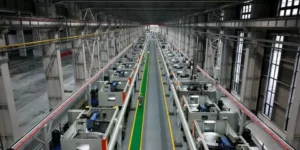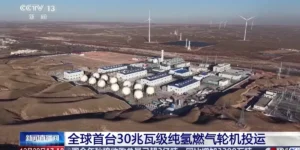Why Do Natural Gas Wells Have Flares? Unveiling the Purpose and Environmental Impacts

Natural gas, a vital component of the world’s energy mix, is extracted from deep within the Earth’s crust through a network of wells and pipelines. If you’ve ever driven past a natural gas well, you might have noticed a tall flame burning at the top. These towering flames are known as flares, and they play a significant role in the oil and gas industry. In this comprehensive exploration, we’ll uncover why do natural gas wells have flares, the purposes they serve, and their impact on the environment.
1. Flaring: A Necessary Process
Flaring involves the controlled burning of excess or unwanted gases from natural gas wells, refineries, and other industrial facilities. It results in the release of carbon dioxide (CO2) and water vapor into the atmosphere. While flaring is often associated with negative environmental consequences, it is sometimes a necessary process in the oil and gas industry.
2. Pressure Relief and Safety
One of the primary purposes of flaring is to ensure safety in oil and gas operations. In cases of overpressure or emergencies, flaring provides a means to release potentially explosive or dangerous gases. This controlled burn prevents catastrophic accidents and protects workers and equipment.
3. Routine Flaring
Routine flaring occurs during regular oil and gas production operations. It is used to dispose of gases that cannot be efficiently captured, processed, or transported. These gases may include methane, which is the primary component of natural gas, as well as other hydrocarbons.
4. Flaring Regulations
Flaring is subject to strict regulations in many countries and regions. These regulations aim to minimize the environmental impact of flaring by limiting the duration, volume, and frequency of flaring events. Companies are often required to report their flaring activities and work to reduce flaring through improved capture and utilization of the released gases.
5. Greenhouse Gas Emissions
One of the most significant concerns regarding flaring is its contribution to greenhouse gas emissions. When natural gas is burned in a flare, it releases CO2 into the atmosphere, contributing to global warming. Efforts to reduce routine flaring and improve gas capture and utilization are driven in part by the desire to mitigate these emissions.
6. Gas Utilization and Alternative Solutions
To address the environmental concerns associated with flaring, the industry is increasingly focused on gas utilization. Instead of burning off excess gas, companies are investing in technologies and infrastructure to capture, process, and transport it for use in energy generation or other industrial applications. This approach not only reduces emissions but also maximizes the economic value of the extracted natural gas.
7. The Future of Flaring
The future of flaring in the oil and gas industry is closely tied to environmental and regulatory developments. Companies are exploring innovative solutions to reduce routine flaring, such as advanced capture technologies, improved storage, and enhanced gas utilization practices.
8. Flaring Reduction Initiatives
Around the world, there is growing recognition of the need to reduce flaring’s environmental impact. Various initiatives and technologies are being employed to tackle this issue:
Gas-to-Liquids (GTL) Technology
GTL technology converts flared gas into valuable liquid products, such as synthetic fuels and chemicals, reducing emissions and maximizing resource utilization.
Methane Capture
Methane, a potent greenhouse gas, is often released during flaring. Capturing and processing this methane for use in energy generation or other applications can significantly reduce emissions.
Zero Flaring Policies
Some regions and companies are adopting zero flaring policies, which aim to eliminate routine flaring entirely. This encourages the development of infrastructure for gas capture and utilization.
9. Advancements in Monitoring and Reporting
Advancements in technology have made it easier to monitor and report flaring activities. Satellite-based monitoring, for example, allows for real-time tracking of flaring events worldwide. This transparency can hold companies accountable and help enforce flaring regulations.
10. Global Efforts to Address Flaring
Internationally, organizations like the World Bank’s Global Gas Flaring Reduction Partnership (GGFR) and the United Nations have set targets to reduce routine flaring. These initiatives aim to collaborate with governments, industry stakeholders, and technology providers to curb flaring and its associated emissions.
11. A Transition to Cleaner Energy
While flaring remains a part of the oil and gas industry, the broader shift toward cleaner and more sustainable energy sources is reshaping the industry’s landscape. Investments in renewable energy, energy efficiency, and carbon capture and storage (CCS) technologies are becoming increasingly significant.
12. The Importance of Consumer Choices
As consumers, our choices also play a role in reducing the demand for fossil fuels and, consequently, the need for flaring. Supporting renewable energy, energy conservation, and sustainable practices can contribute to a future with less reliance on fossil fuels and their associated environmental impacts.

Natural gas flare in an oil field, image source: Unsplash
13. Economic Implications of Flaring
Beyond its environmental consequences, flaring also has economic implications. When natural gas is flared, it represents wasted resources that could otherwise be monetized. This loss of potential revenue can impact the profitability of oil and gas operations. Therefore, minimizing flaring not only benefits the environment but also makes economic sense for energy companies.
14. Technological Innovations
The push to reduce flaring has led to technological innovations. Advanced flare gas recovery systems (FGRS) are being deployed to capture and process flared gases more efficiently. These systems can convert flared gas into usable energy, further reducing waste and emissions.
15. Regulatory Frameworks
Governments and regulatory bodies worldwide are implementing stricter regulations and penalties for excessive flaring. These measures encourage energy companies to invest in gas capture and utilization technologies and to adopt best practices to reduce flaring.
16. Social and Health Impacts
In addition to environmental and economic concerns, flaring can have social and health impacts on nearby communities. The release of pollutants from flaring, including sulfur dioxide and particulate matter, can lead to air quality issues and health problems for local residents. Reducing flaring can improve the quality of life for these communities.
17. Global Energy Transition
The global shift toward cleaner and more sustainable energy sources is reshaping the energy landscape. As renewable energy technologies become more prevalent and affordable, there is less reliance on fossil fuels like natural gas. This transition will naturally reduce the need for flaring in the long term.

Natural gas flares on an offshore oil rig, image source: Unsplash
18. Carbon Offsetting
Some companies are exploring carbon offset programs to mitigate the environmental impact of flaring. These programs involve investing in projects that reduce or capture carbon emissions elsewhere to balance out the emissions generated by flaring.
19. Public Awareness and Advocacy
Public awareness of environmental issues, including flaring, has been growing. Environmental advocacy groups and concerned citizens are putting pressure on governments and energy companies to take action to reduce flaring and its associated environmental harm.
Conclusion: Balancing Safety and Environmental Concerns
Flaring at natural gas wells serves as a safety measure and a means to manage unwanted gases. While it is a necessary practice in certain situations, it also presents environmental challenges, particularly in terms of greenhouse gas emissions. As the world transitions to cleaner energy sources and stricter environmental regulations, the industry is working to find a balance between safety and environmental responsibility.
The reduction of routine flaring, increased gas utilization, and the development of sustainable energy solutions are all part of the ongoing effort to minimize the environmental impact of natural gas extraction and production.






